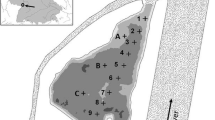Abstract
Sediments from four lakes polluted by effuents from steel industries and from two reference lakes were investigated. The sediments contained elevated concentrations of oil, Pb, Cd, Hg, Zn, Ni and Cr in different combinations. The toxicity of the polluted sediments to Daphnia was much higher than reported elsewhere (24-h LC50 0.5–1.5 vol%). Tubifex survived more than 3 months in the polluted sediments, but growth and reproduction were inhibited.
Similar content being viewed by others
References
Adams, W. J., P. S. Ziegenfuss, W. J. Renaudette & R. G. Mosher, 1986. Comparison of laboratory and field methods for testing the toxicity of chemicals sorbed to sediments. In: Aquatic Toxicology and Environmental Fate: Ninth Volume, ASTM STP 921, T. M. Poston and R. Purdy, Eds., American Society for Testing and Materials, Philadelphia, p. 494.
Chapman, P. M., R. C. Barrick, J. M. Neff & R. C. Swartz, 1987. Four independent approaches to developing sediment quality criteria yield similar values for model contaminants: Environmental Toxicology and Chemistry, 6: 723–725.
Dave, G., 1984. Effects of fluoride on growth, reproduction and survival in Daphnia magna: Comparative Biochemistry and Physiology, 78C: 425–431.
Dillon, T., 1983. The effects of storage temperature and time on sediment toxicity: Poster presentation, Fourth Annual SETAC Meeting, Arlington, VA, February 6–9, 1983.
Douglas, M. T., D. O. Chanter, I. B. Pell & G. M. Burney, 1986. A proposal for the reduction of animal numbers required for the aquate toxicity fish test (LC50 determination): Aquatic Toxicology, 8: 243–249.
Gersich, F. M., F. A. Blanchard, S. L. Applegath & C. N. Park, 1986. The precision of daphnid (Daphnia magna Straus, 1820) static acute toxicity tests: Archives of Environmental Contamination and Toxicology, 15: 741–749.
Håkanson, L., 1981. Lake sediments in aquatic pollution control programs; principles, processes and practical examples: Swedish Environmental Protection Board PM 1398, 242 pp., in Swedish with English summary.
ISO, International Organization for Standardization, 1982. Water quality — Determination of the inhibition of the mobility of Daphnia magna Straus (Cladocera, Crustacea): ISO 6341-1982.
LeBlanc, G. A. and D. C. Surprenant, 1985. A method of assessing the toxicity of contamined freshwater sediments. In: Aquatic Toxicology and Hazard Assessment: Seventh Symposium, ASTM STP 854, R. D. Cardwell, R. Purdy & R. C. Balmer, Eds., American Society for Testing and Materials, Philadelphia, p. 269–283.
Malueg, K. W., G. S. Schuytema and D. F. Krawczyk, 1986. Effects of sample storage on a copper-spiked freshwater sediment: Environmental Toxicology and Chemistry, 5: 245–253.
Nebeker, A. V., M. A. Cairns, J. H. Gakstatter, K. W. Malueg, G. S. Schuytema and D. F. Krawczyk, 1984. Biological methods for determining toxicity of contaminated freshwater sediments to invertebrates: Environmental Toxicology and Chemistry 2: 617–630.
Shaner, S. W. and A. W. Knight, 1985. The role of alkalinity in the mortality of Daphnia magna in bioassays of sediment-bound copper: Comparative Biochemistry and Physiology, 82C: 273–277.
Wiederholm, T., 1984. Incidence of deformed chironomid larvae in Swedish lakes: Hydrobiologia 109: 243–249.
Wiederholm, T., A.-M. Wiederholm & G. Milbrink, 1987. Bulk sediment bioassays with five species of fresh-water oligochaetes: Water, Air, and Soil Pollution 36: 131–154.
Author information
Authors and Affiliations
Rights and permissions
About this article
Cite this article
Wiederholm, T., Dave, G. Toxicity of metal polluted sediments to Daphnia magna and Tubifex tubifex . Hydrobiologia 176, 411–417 (1989). https://doi.org/10.1007/BF00026574
Issue Date:
DOI: https://doi.org/10.1007/BF00026574




